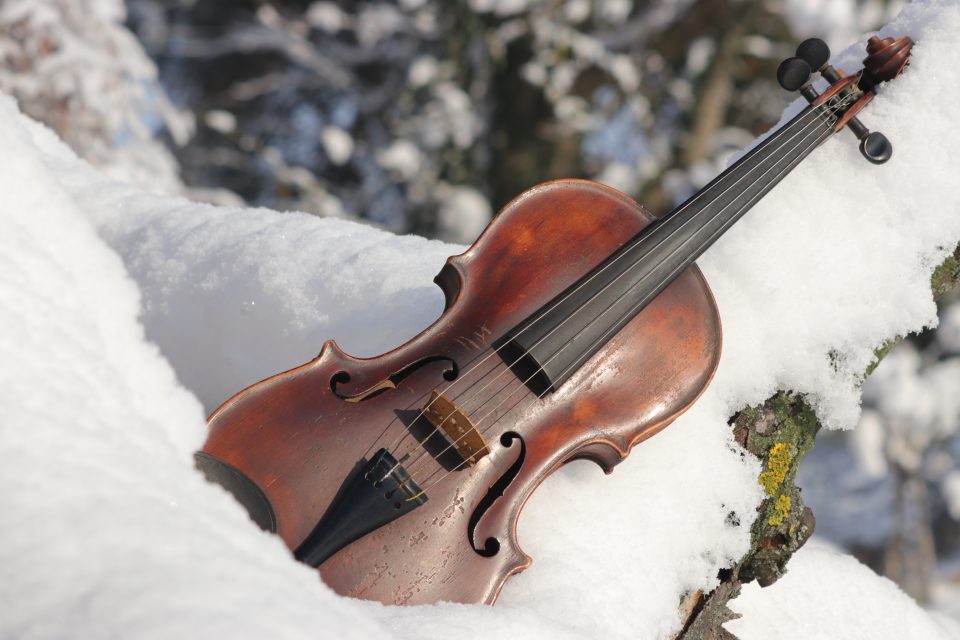Changing weather can have a huge impact on your string instrument. Understanding how it responds to seasonal changes is vital. How well you manage these changes is key to protecting your instrument as well as your investment.
As one season gives way to the next, you may notice subtle changes with your string instrument. For instance, in autumn you might discover the need to tune the instrument more often because the pegs are loose, the strings sound flat, or have completely spun out. This is due to summer’s heat and humidity giving way to autumn’s cooler and drier air. While the air continues to lose moisture, your string instrument which is made with a variety of woods including maple, spruce and ebony, will contract and expand at different rates to compensate for the moisture loss or gain.
Excessive temperatures and humidity changes can be stressful on bowed instruments creating problems such as cracks, split seams and weak joints to name a few. They respond best when temperature fluctuations are minimal with a stable climate of 65-75oF (https://www.violinist.com/discussion/archive/25123/) and 40-60% humidity, according to (https://www.violinist.com/blog/laurie/201911/27976/). This can be a challenge during winter months when air temperatures can plummet sharply. Never leave your instrument inside a vehicle in cold weather; it is best to take it with you. When not in use, keep your instrument in its case away from heaters, vents and cold drafts. Consider purchasing a humidifier if the air is especially dry; doing so will help protect your instrument throughout the winter.
While warmer months are more favorable for string instruments, they are not without their dangers. Like the cooler months, the pegs and strings typically are the first to sense a change as temperatures warm up filling the air with moisture. This can cause the pegbox to swell as humidity builds causing the pegs to stick as if “locked” into place. Unable to move, the tension in the strings can build making them go sharp or break. The bridge can be affected as well. Overusing the pegs can add tension causing the bridge to warp or collapse which can significantly damage the instrument, including the sound post.
Summer’s extreme temperatures along with increased humidity can also cause serious damage to your instrument. If left inside a car or trunk the varnish can melt beyond repair. Structurally, the heat and humidity can cause open seams and cracks to develop as the instrument expands from excessive moisture. The glue can also soften or melt compromising its integrity in a very short amount of time. As the season progresses, if humidity becomes problematic, a de-humidifier can bring your instrument back into balance staying within the 40-60% range. And remember to keep the air temperature between 65-75oF as well as away from air conditioning vents, fans or prolonged exposure to the sun and heat.
As the weather shifts from one season to the next, knowing how your string instrument may respond and the steps you can take to protect it are essential. Not only will you protect your investment, you will also enhance your performance.
Weather Tips for Protecting Your String Instrument
-
- Your instrument is an extension of you. If you are uncomfortable, your instrument is as well.
-
- Maintaining a stable climate of 65-75oF and humidity level of 40-60% is essential.
-
- An accurate hygrometer will take the guesswork out of knowing the moisture content of the air surrounding your instrument.
-
- If the air is too dry investing in a humidifier can prove beneficial. If moisture is the problem, purchasing a de-humidifier can be worthwhile.
-
- For added protection, a silk instrument bag is an affordable option. As a natural fiber, silk can create a barrier against abrupt humidity and temperatures throughout the seasons. A tightly woven cotton towel or blanket will also achieve the same goal.
-
- When transitioning from one environment to another, allow your instrument to acclimate in the case for several minutes (20-30 min) before opening as well as once the case has been opened before playing. Both you and your instrument will be glad you did.
-
- When not in use, store your instrument in its case away from heaters, vents, and away from air conditioners and cold drafts.
-
- Never, ever leave your instrument in the seat of a vehicle or trunk. In the summer, temperatures can reach well over 100oF and in the winter below freezing.
-
- Treat your bow with the same care as your instrument as well as loosen it after each use.


